Rhenium Nanochemistry for Catalyst Preparation
Abstract
:1. Introduction
2. Rhenium (VII) Oxide Based Nanostructures
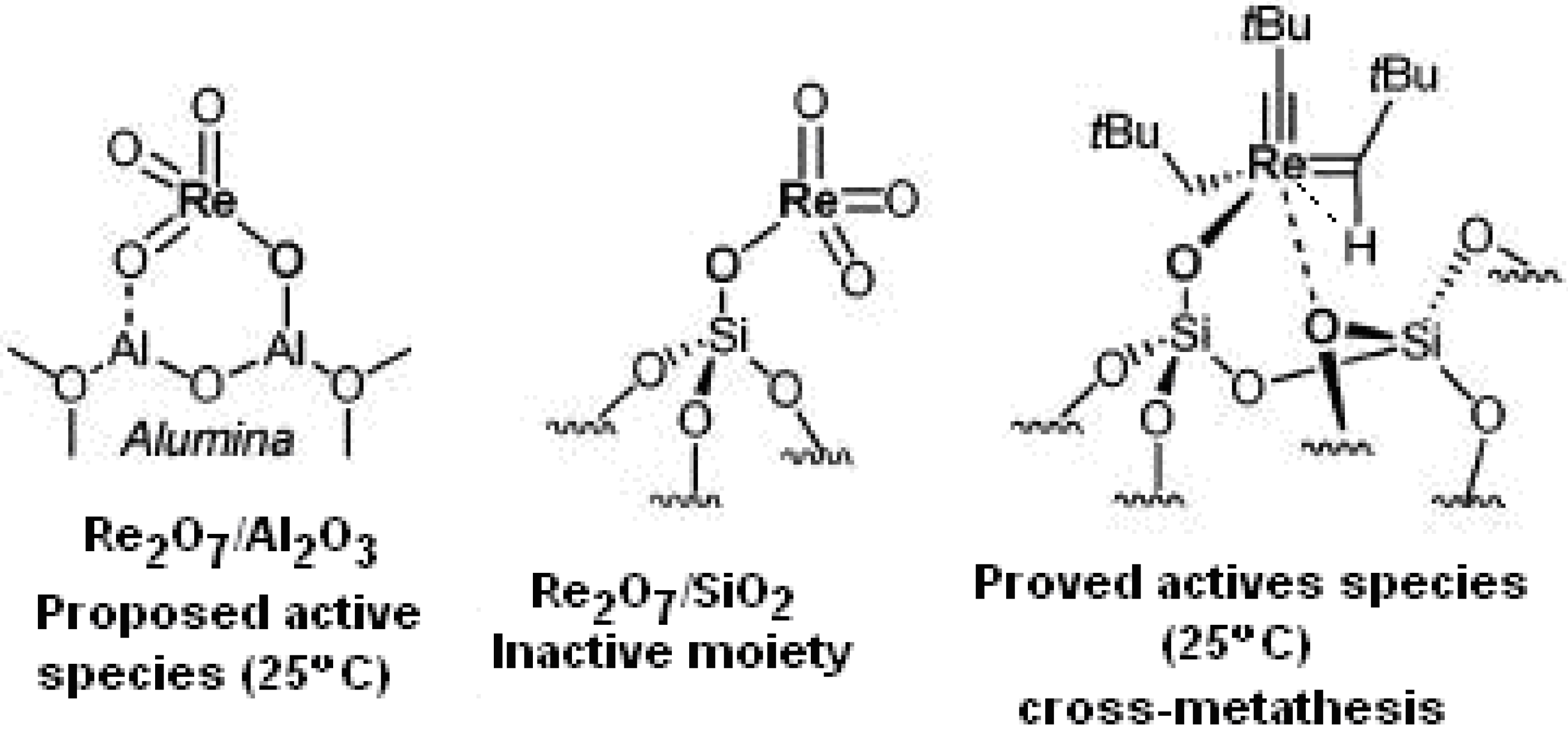

3. Methyltrioxorhenium Based Nanocomposites and Nanostructures



4. Metal Alkoxide Derived Nanocomposites


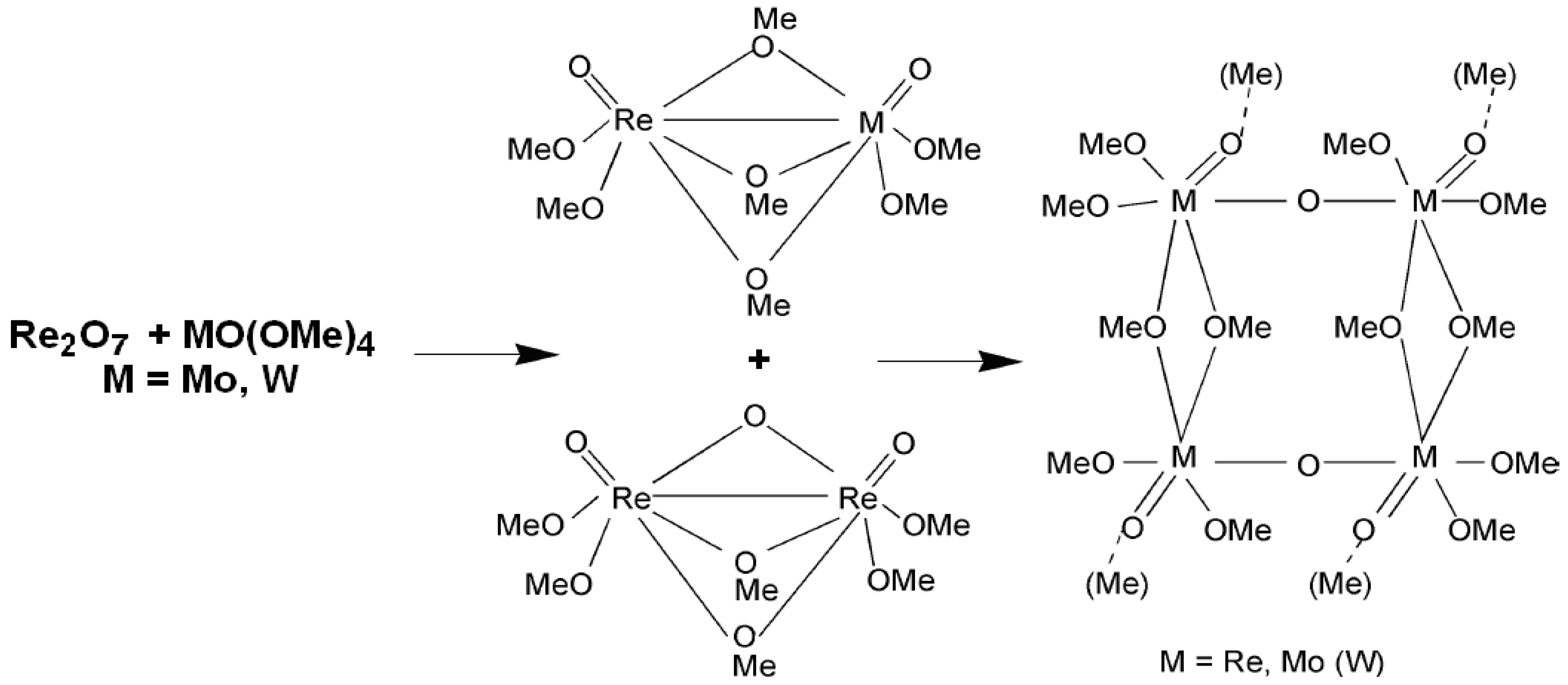
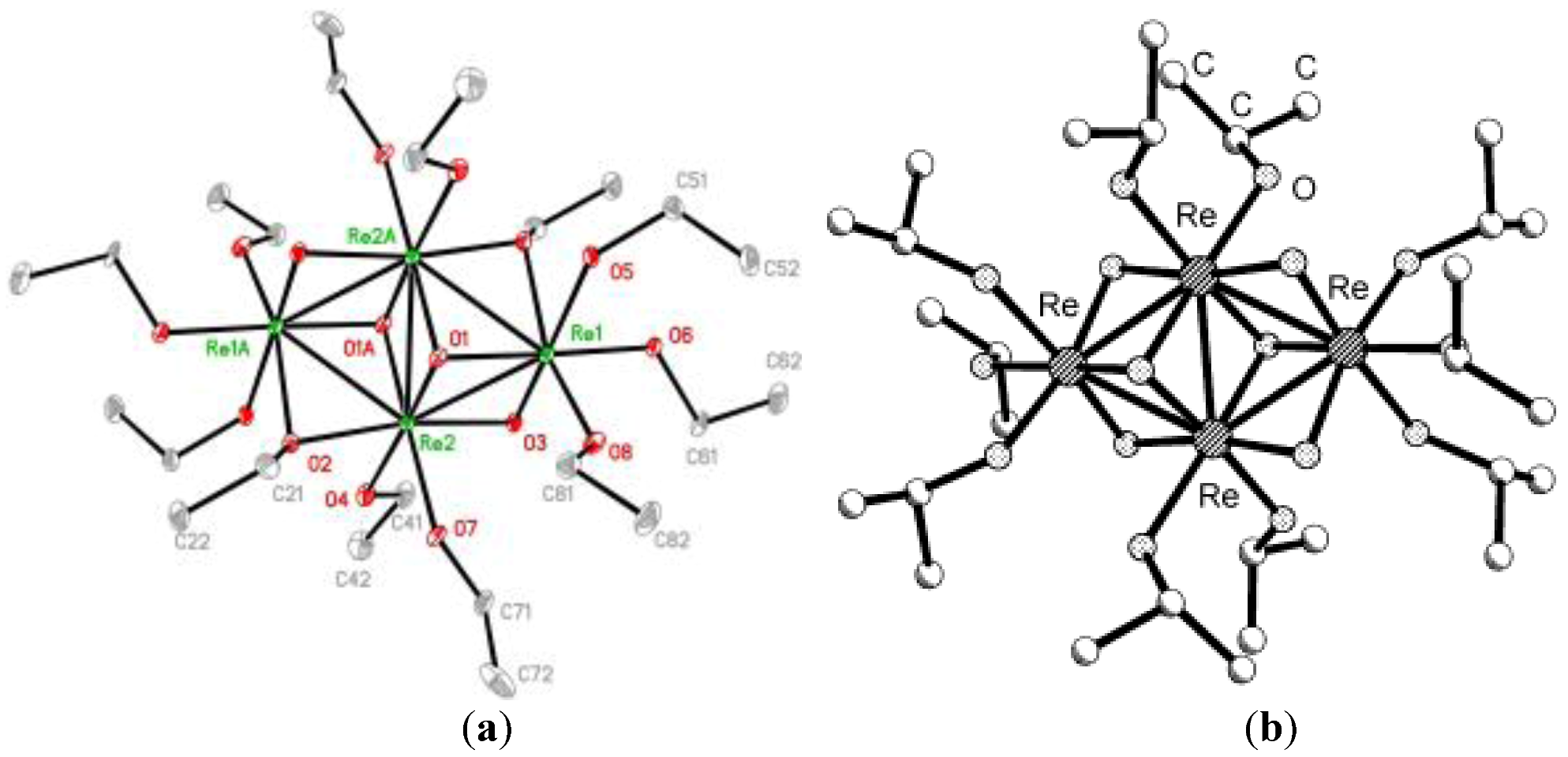

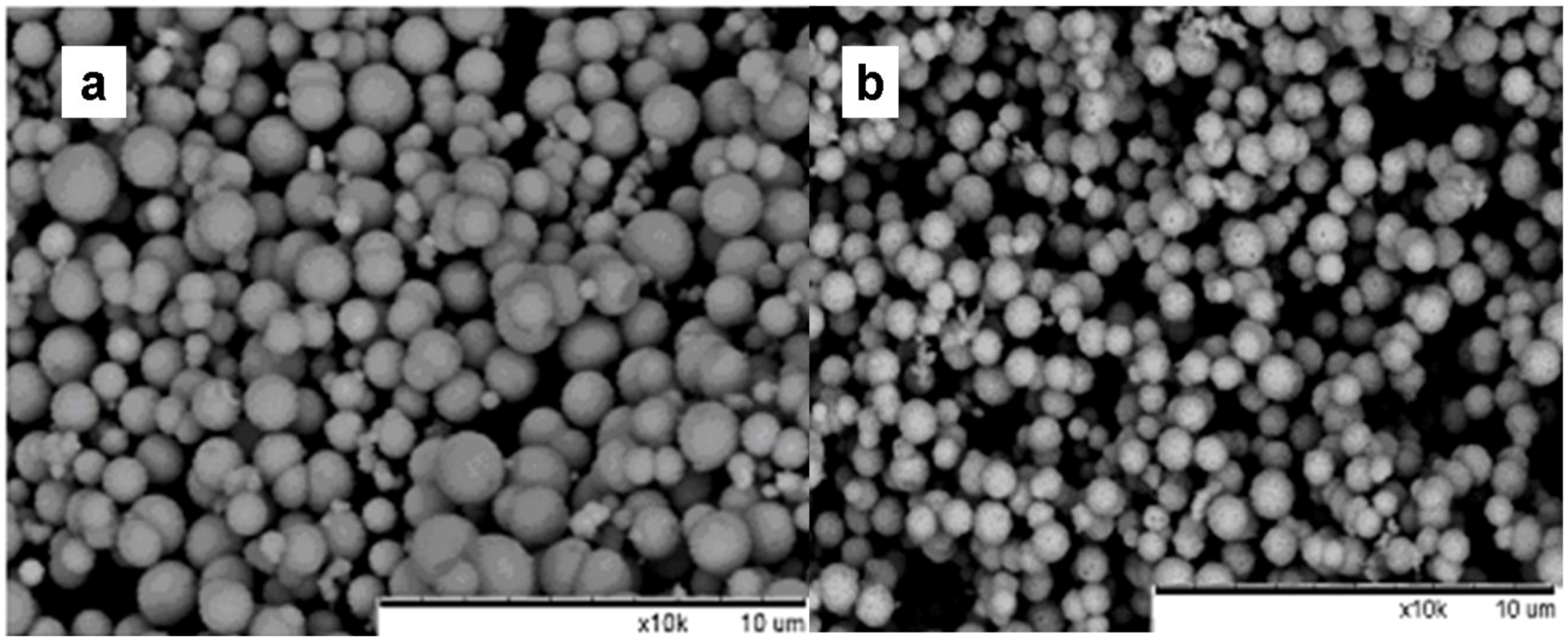
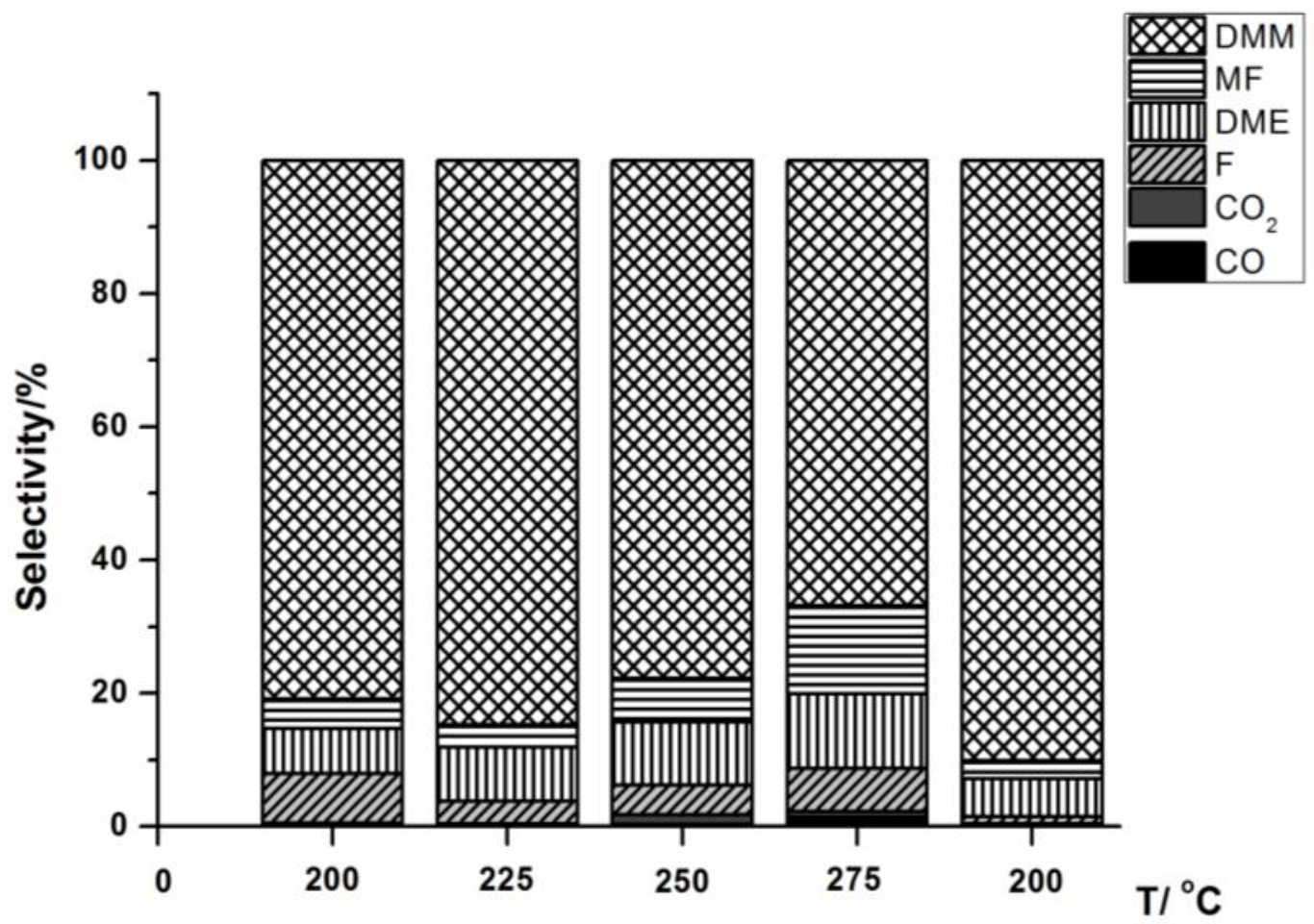
5. Rhenium Sulfide Based Nanocomposites

| Preparation technique and catalyst load | k(HDS) | k(BP) | k(CHB) | k(HDN) | k(HYD) |
|---|---|---|---|---|---|
| New method, 9 wt % Mo/Al2O3 | 2.4 | 1.9 | 0.5 | 9.2 | 5.1 |
| Traditional method, 8 wt % Mo/Al2O3 | 2.7 | 2.4 | 0.3 | 4.6 | 3.3 |
| New method, 6 wt % Re/Al2O3 | 2.0 | 2.0 | 0.0 | 6.4 | 0.5 |
| Traditional method, 6 wt % Re/Al2O3 | 3.7 | 3.7 | 0.0 | 2.0 | 0.4 |
6. Conclusions
Acknowledgments
References
- Mol, J.C. Industrial applications of olefin metathesis. J. Mol. Catal. A Chem. 2004, 213, 39–45. [Google Scholar] [CrossRef]
- Xiao, J.; Puddephatt, R.J. Pt–Re clusters and bimetallic catalysts. Coord. Chem. Rev. 1995, 143, 457–500. [Google Scholar]
- Guryev, Y.V.; Ivanova, I.I.; Lunin, V.V.; Grünert, W.; van den Berg, M.V.E. Characterization of metal segregation in Pt-Re/Al2O3 reforming catalysts. Appl. Catal. A 2007, 329, 16–21. [Google Scholar] [CrossRef]
- Laurenti, D.; Ninh Thi, K.T.; Escalona, N.; Massin, L.; Vrinat, M.; Llambias, F.J.G. Support effect with rhenium sulfide catalysts. Catal. Today 2008, 130, 50–55. [Google Scholar]
- Okal, J.; Kubicka, H. Influence of oxidation-reduction treatment on activity and selectivity of Re supported on gamma-alumina. Appl. Catal. A 1998, 171, 351–359. [Google Scholar]
- Escalona, N.; Vrinat, M.; Laureni, D.; Llambias, F.J.G. Rhenium sulfide in hydrotreating. Appl. Catal. A 2007, 322, 113–120. [Google Scholar] [CrossRef]
- Räty, J.; Pakkanen, T.A. Controlled gas-phase preparation and HDS activity of Re-2(CO)(10)/alumina catalysts. Catal. Lett. 2000, 65, 175–180. [Google Scholar] [CrossRef]
- Escalona, N.; Llambias, F.J.G.; Vrinat, M.; Nguyen, T.S.; Laurenti, D.; Agudo, A.L. Highly active ReS2/gamma-Al2O3 catalysts: Effect of calcination and activation over thiophene hydrodesulfurization. Catal. Comm. 2007, 8, 285–288. [Google Scholar] [CrossRef]
- Escalona, N.; Ojeda, J.; Cid, R.; Alves, G.; Agudo, A.L.; Fierro, J.L.; Llambias, F.J.G. Characterization and reactivity of Re(x)/gamma-Al2O3 catalysts in hydrodesulfurization and hydrodenitrogenation of gas oil: Effect of Re loading. Appl. Catal. A 2002, 234, 45–54. [Google Scholar] [CrossRef]
- Wang, L.; Ohnishi, R.; Ichikawa, M. Selective dehydroaromatization of methane toward benzene on Re/HZSM-5 catalysts and effects of CO/CO2 addition. J. Catal. 2000, 190, 276–283. [Google Scholar]
- Shu, Y.; Ohnishi, R.; Ichikawa, M. Improved methane dehydrocondensation reaction on HMCM-22 and HZSM-5 supported rhenium and molybdenum catalysts. Appl. Catal. A 2003, 252, 315–329. [Google Scholar] [CrossRef]
- Wang, L.S.; Murata, K.; Inaba, M. Production of pure hydrogen and more valuable hydrocarbons from ethane on a novel highly active catalyst system with a Pd-based membrane reactor. Catal. Today 2003, 82, 99–104. [Google Scholar]
- Burch, R.; Paun, C.; Cao, X.M.; Crawford, P.; Goodrich, P.; Hardacre, C.; Hu, P.; McLaughlin, L.; Sa, J.; Thompson, J.M. Catalytic hydrogenation of tertiary amides at low temperatures and pressures using bimetallic Pt/Re-based catalysts. J. Catal. 2011, 283, 89–97. [Google Scholar]
- Chayakul, K.; Srithanratana, T.; Hengrasmee, S. Catalytic activities of Re-Ni/CeO(2) bimetallic catalysts for water gas shift reaction. Catal. Today 2011, 175, 420–429. [Google Scholar]
- Chang, A.S.Y.; Chen, W.; Wang, H.; Rowe, J.E.; Madey, T.E. Methanol reactions over oxygen-modified Re surfaces: Influence of surface structure and oxidation. J. Phys. Chem. B 2004, 108, 14643–14651. [Google Scholar]
- Yuan, Y.; Shido, T.; Iwasawa, Y. The new catalytic property of supported rhenium oxides for selective oxidation of methanol to methylal. Chem. Comm. 2000, 1421–1422. [Google Scholar]
- Tsoncheva, T.; Vankova, S.; Bozhkov, O.; Mehandjiev, D. Rhenium and manganese modified activated carbon as catalyst for methanol decomposition. Can. J. Chem. 2007, 85, 118–123. [Google Scholar] [CrossRef]
- Kusakari, T.; Sasaki, T.; Iwasawa, Y. Selective oxidation of benzene to phenol with molecular oxygen on rhenium/zeolite catalysts. Chem. Comm. 2004, 992–993. [Google Scholar]
- Salameh, A.; Baudoin, A.; Daravong, S.; Boehm, V.; Roeper, M.; Basset, J.M.; Coperet, C. CH3-ReO3 on gamma-Al2O3: Activity, selectivity, active site and deactivation in olefin metathesis. J. Catal. 2008, 253, 180–190. [Google Scholar]
- Mol, J.C. Catalytic metathesis of unsaturated fatty acid esters and oils. Topics Catal. 2004, 27, 97–104. [Google Scholar]
- Onaka, M.; Oikawa, T. Olefin metathesis over mesoporous alumina-supported rhenium oxide catalyst. Chem. Lett. 2002, 850–851. [Google Scholar] [CrossRef]
- Bakala, P.C.; Briot, E.; Millot, Y.; Piquemal, J.Y.; Bregeault, J.M. Comparison of olefin metathesis by rhenium-containing γ-alumina or silica–aluminas and by some mesoporous analogues. J. Catal. 2008, 258, 61–70. [Google Scholar]
- Oikawa, T.; Ookoshi, T.; Tanaka, T.; Yamamoto, T.; Onaka, M. A new heterogeneous olefin metathesis catalyst composed of rhenium oxide and mesoporous alumina. Micropor. Mesopor. Mater. 2004, 74, 93–103. [Google Scholar] [CrossRef]
- Jain, K.R.; Kühn, F.E. Immobilization of organorhenium (VII) oxides. J. Organomet. Chem. 2007, 692, 5532–5540. [Google Scholar]
- Salameh, A.; Joubert, J.; Baudouin, A.; Lukens, W.; Delbecq, F.; Sautet, P.; Basset, J.M.; Coperet, C. CH3ReO3 on γ-Al2O3: Understanding its structure, initiation, and reactivity in olefin metathesis. Angew. Chem.Int. Ed. 2007, 46, 1–5. [Google Scholar]
- Mandelli, D.; van Vliet, M.C.A.; Arnold, U.; Sheldon, R.A.; Schuchardt, U. Epoxidation of alkenes with hydrogen peroxide catalyzed by ReO4-SiO2 center dot Al2O3 and ReO4-Al2O3. J. Mol. Catal. A 2001, 168, 165–171. [Google Scholar] [CrossRef]
- Buffon, R.; Auroux, A.; Lefebvre, F.; Leconte, M.; Choplin, A.; Basset, J.M. A surface organomatallic approach to the syntrhesis of rhenium-based catalysts for the metathesis of olefins: CH3ReO3/Nb2O5. J. Mol. Catal. 1992, 76, 287–295. [Google Scholar] [CrossRef]
- Buffon, R.; Choplin, A.; Leconte, M.; Basset, J.M. Surface organometallic chemistry of rhenium: Attempts to characterize a surface carbene in metathesis of olefins with the catalyst CH3ReO3/Nb2O5. J. Mol. Catal. 1992, 72, L7–L10. [Google Scholar] [CrossRef]
- Scheiring, T.; Klein, A.; Kaim, W. EPR study of paramagnetic rhenium (I) complexes (bpy(center dot-))Re(CO)3X relevant to the mechanism of electrocatalytic CO2 reduction. J. Chem Soc., Perkin Trans. 1997, 2, 2569–2571. [Google Scholar]
- Cecchet, F.; Alebbi, M.; Bignozzi, C.A.; Paolucci, F. Efficiency enhancement of the electrocatalytic reduction of CO2: fac-[Re(v-bpy)(CO)3Cl] electropolymerized onto mesoporous TiO2 electrodes. Inorg. Chim. Acta 2006, 359, 3871–3874. [Google Scholar] [CrossRef]
- Chen, Y.; Liu, W.; Jin, J.S.; Liu, B.; Zou, Z.G.; Zou, J.L.; You, X.Z. Rhenium (I) tricarbonyl complexes with bispyridine ligands attached to sulfur-rich core: Syntheses, structures and properties. J. Organom. Chem. 2009, 694, 763–770. [Google Scholar]
- Coperet, C. Molecular design of heterogeneous catalysts: the case of olefin metathesis. New. J. Chem. 2004, 28, 1–10. [Google Scholar] [CrossRef]
- Balcar, H.; Hamtil, R.; Zilkova, N.; Zhang, Z.; Pinnavaia, T.J.; Cejka, J. Re(VII) oxide on mesoporous alumina of different types—Activity in the metathesis of olefins and their oxygen-containing derivatives. Appl. Catal. A 2007, 320, 56–63. [Google Scholar] [CrossRef]
- Salameh, A.; Coperet, C.; Basset, J.M.; Böhm, V.P.W.; Röper, M. Rhenium (VII) oxide/aluminumoxide: More experimental evidence for an oxametallacyclobutane intermediate and a pseudo-Wittig initiation stepin olefin metathesis. Adv. Synth. Catal. 2007, 349, 238–242. [Google Scholar] [CrossRef]
- Marquez-Alvarez, C.; Zilkova, N.; Perez-Pariente, J.; Cejka, J. Synthesis, characterization and catalytic applications of organized mesoporous alumina. Catal. Rev. Sci. Eng. 2008, 50, 222–286. [Google Scholar] [CrossRef]
- Herrmann, W.A.; Rost, A.M.J.; Mitterpleininger, J.K.M.; Szesni, N.; Sturm, S.; Fischer, R.W.; Kühn, F.E. A cheap, efficient, and environmentally benign synthesis of the versatile catalyst methyltrioxorhenium (MTO). Angew. Chem. Int. Ed. 2007, 46, 7301–7303. [Google Scholar]
- Jain, K.R.; Herrmann, W.; Kühn, F. Synthesis and catalytic applications of chiral monomeric organomolybdenum (VI) and organorhenium (VII) oxides in homogeneous and heterogeneous phase. Coord. Chem. Rev. 2008, 252, 556–568. [Google Scholar]
- Oikawa, T.; Masui, Y.; Tanaka, T.; Chujo, Y.; Onaka, M. Lewis acid-modified mesoporous alumina: A new catalyst carrier for methyltrioxorhenium in metathesis of olefins bearing functional groups. J. Organom. Chem. 2007, 692, 554–561. [Google Scholar]
- Frech, C.M.; Blacque, O.; Schmalle, H.W.; Berke, H.; Adlhart, C.; Chen, P. Unprecedented ROMP activity of low-valent rhenium–nitrosyl complexes: Mechanistic evaluation of an electrophilic olefin metathesis system. Chem. Eur. J. 2006, 12, 3325–3338. [Google Scholar] [CrossRef]
- Bal, R.; Tada, M.; Kusakari, T.; Iwasawa, Y. Direct phenol synthesis from Benzene with molecular oxygen on rhenium/zeolite catalysts. Catal. Catal. 2005, 47, 72–74. [Google Scholar]
- Viswanadham, N.; Shido, T.; Iwasawa, Y. Performances of rhenium oxide-encapsulated ZSM-5 catalysts in propene selective oxidation/ammoxidation. Appl. Catal. A 2001, 219, 223–233. [Google Scholar] [CrossRef]
- Viswanadham, N.; Shido, T.; Sasaki, T.; Iwasawa, Y. Ammonia-promoted rhenium-cluster formation in CH3ReO3-encapsulated H-ZSM-5 relevant to the performance of the catalytically selective oxidation/ammoxidation of propene. J. Phys. Chem. B. 2002, 106, 10955–10963. [Google Scholar]
- Seisenbaeva, G.A.; Gohil, S.; Kessler, V.G. Sol-Gel Methods for Materials Processing; Innocenzi, P., Zub, Y., Kessler, V.G., Eds.; Springer: Dordrecht, Netherlands, 2008; pp. 397–403. [Google Scholar]
- Edwards, P.G.; Wilkinson, G.; Hursthouse, M.B.; Malik, K.M.A. Improved syntheses of tetrachloro-oxorhenium (VI) and chlorotrioxo-rhenium (VII). Synthesis of alkoxo- and dialkylamido-rhenium com-pounds. The crystal and molecular structures of di-µ-methoxo-tetramethoxo-µ-oxo-dioxodirhenium (VI) (Re–Re), bis [lithium pentaiso-propoxo-oxorhenate (VI)–lithiumchloride–tetrahydrofuran(1/1/2)], and trans-tetraphenoxobis(trimethylphosphine)rhenium (IV). J. Chem. Soc. Dalton Trans. 1980, 2467–2472. [Google Scholar]
- Seisenbaeva, G.A.; Shevelkov, A.V.; Kloo, L.; Gohil, S.; Tegenfeldt, J.; Kessler, V.G. Homo- and heterometallic rhenium oxomethoxide complexes with a M4(μ-O)2(μ-OMe)4 planar core—a new family of metal alkoxides with peculiar structural disorder. Preparation and X-ray single crystal study. J. Chem. Soc. Dalton Trans. 2001, 2762–2768. [Google Scholar]
- Kessler, V.G.; Shevelkov, A.V.; Khvorykh, G.V.; Seisenbaeva, G.A.; Turova, N.Y.; Drobot, D.V. Electrochemical synthesis and physicochemical properties of rhenium(V) oxomethoxide, Re4O2(OMe)16. J. Inorg. Chem. 1995, 40, 1477–1483. [Google Scholar]
- Kessler, V.G.; Seisenbaeva, G.A.; Shevelkov, A.V.; Khvorykh, G.V. Synthesis, crystal, molecular and electronic structure of a novel heterobinuclear alkoxide cluster (MeO)2ReO(μ-OMe)3 MoO(OMe)2. J. Chem. Soc. Chem. Commun. 1995, 1779–1780. [Google Scholar]
- Kustov, A.L.; Kessler, V.G.; Romanovsky, B.V.; Seisenbaeva, G.A.; Drobot, D.V.; Shcheglov, P.A. Supported Re and Mo oxides prepared using binuclear precursors: Synthesis and characterization. J. Mol Catal. 2004, 216, 101–106. [Google Scholar] [CrossRef]
- Seisenbaeva, G.A.; Sundberg, M.; Nygren, M.; Dubrovinsky, L.; Kessler, V.G. Thermal decomposition of the methoxide complexes MoO(OMe)4, Re4O6(OMe)12 and (Re1-xMox)O6(OMe)12 (0.24 ≤ x ≤ 0.55). Mater. Chem. Phys. 2004, 87, 142–148. [Google Scholar] [CrossRef]
- Nikonova, O.A.; Jansson, K.; Kessler, V.G.; Sundberg, M.; Baranov, A.I.; Shevelkov, A.V.; Drobot, D.V.; Seisenbaeva, G.A. Electrochemical synthesis, structural characterization and decomposition of rhenium oxoethoxide. Inorg. Chem. 2008, 44, 1295–1300. [Google Scholar]
- Nikonova, O.A.; Kessler, V.G.; Seisenbaeva, G.A. Substitution features in the isomorphous replacement series for metal-organic compounds (NbxTa1-x)4O2(OMe)14(ReO4)2, x= ¼ 0.7, 0.5, 0.3—Single-source precursors of complex oxides with organized porosity. J. Solid State Chem. 2008, 181, 3294–3302. [Google Scholar] [CrossRef]
- Nikonova, O.A.; Kessler, V.G.; Drobot, D.V.; Shcheglov, P.A.; Seisenbaeva, G.A. Synthesis and X-ray single crystal study of niobium and tantalum Oxo-ethoxo-perrhenates, MV4O2(OEt)14(ReO4)2. Polyhedron 2007, 26, 862–866. [Google Scholar] [CrossRef]
- Nikonova, O.; Nedelec, J.M.; Kessler, V.G.; Seisenbaeva, G.A. Precursor-directed assembly of complex oxide nanobeads. The role of strongly coordinated inorganic anions. Langmuir 2011, 27, 11622–11628. [Google Scholar]
- Nikonova, O.A.; Capron, M.; Fang, G.; Faye, J.; Mamede, A.S.; Jalowiecki-Duhamel, L.; Dumeignil, F.; Seisenbaeva, G.A. Novel approach to rhenium oxide catalysts for selective oxidation of methanol to DMM. J. Catal. 2011, 279, 310–318. [Google Scholar]
- Secordel, X.; Yoboue, A.; Cristol, S.; Lancelot, C.; Capron, M.; Paul, J.F.; Berrier, E. Supported oxorhenate catalysts prepared by thermal spreading of metal Re(0) for methanol conversion to methylal. J. Solid State Chem. 2011, 184, 2806–2811. [Google Scholar]
- Davenport, W.H.; Kollonitsch, V.; Kline, C.H. Advances in rhenium catalysts. Ind. Eng. Chem. 1968, 60, 10–11. [Google Scholar]
- Seisenbaeva, G.A.; Gohil, S.; Jansson, K.; Herbst, K.; Brorson, M.; Kessler, V.G. Solution interaction of O-donor ligand metal complexes with thiocarbonyl compounds—a new general route to metal sulfide materials. New J. Chem. 2003, 27, 1059–1064. [Google Scholar]
© 2012 by the authors; licensee MDPI, Basel, Switzerland. This article is an open-access article distributed under the terms and conditions of the Creative Commons Attribution license (http://creativecommons.org/licenses/by/3.0/).
Share and Cite
Kessler, V.G.; Seisenbaeva, G.A. Rhenium Nanochemistry for Catalyst Preparation. Minerals 2012, 2, 244-257. https://doi.org/10.3390/min2030244
Kessler VG, Seisenbaeva GA. Rhenium Nanochemistry for Catalyst Preparation. Minerals. 2012; 2(3):244-257. https://doi.org/10.3390/min2030244
Chicago/Turabian StyleKessler, Vadim G., and Gulaim A. Seisenbaeva. 2012. "Rhenium Nanochemistry for Catalyst Preparation" Minerals 2, no. 3: 244-257. https://doi.org/10.3390/min2030244






